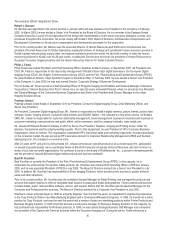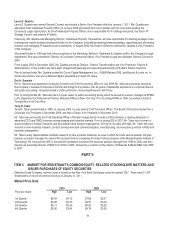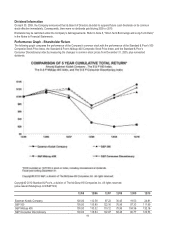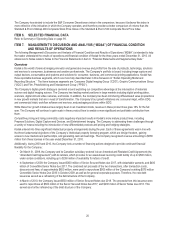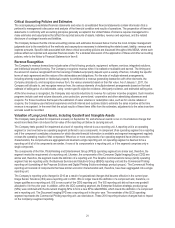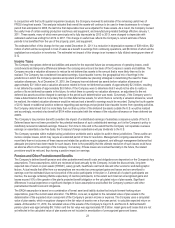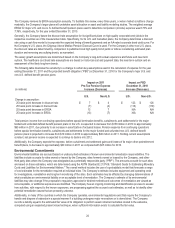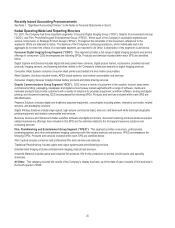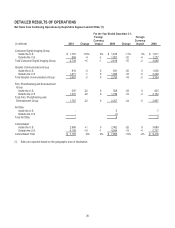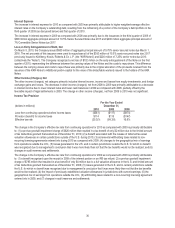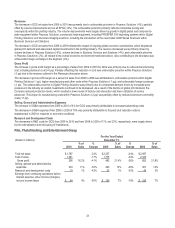Kodak 2010 Annual Report Download - page 25
Download and view the complete annual report
Please find page 25 of the 2010 Kodak annual report below. You can navigate through the pages in the report by either clicking on the pages listed below, or by using the keyword search tool below to find specific information within the annual report.23
In conjunction with the fourth quarter impairment analysis, the Company reviewed its estimates of the remaining useful lives of
FPEG’s long-lived assets. This analysis indicated that overall the assets will continue to be used in these businesses for a longer
period than anticipated in 2008, the last time that depreciable lives were adjusted for these assets. As a result, the Company revised
the useful lives of certain existing production machinery and equipment, and manufacturing-related buildings effective January 1,
2011. These assets, many of which were previously set to fully depreciate by 2012 to 2013, were changed to depreciate with
estimated useful lives ending from 2014 to 2017. This change in useful lives reflects the Company’s current estimate of future
periods to be benefited from the use of the property, plant, and equipment.
The estimated effect of this change for the year ended December 31, 2011 is a reduction in depreciation expense of $38 million, $32
million of which will be recognized in Cost of sales as a benefit to earnings from continuing operations, and $6 million of which will be
capitalized as a reduction in inventories. The estimated net impact of this change is an increase in fully diluted earnings per share of
$.12.
Income Taxes
The Company recognizes deferred tax liabilities and assets for the expected future tax consequences of operating losses, credit
carryforwards and temporary differences between the carrying amounts and tax basis of the Company’s assets and liabilities. The
Company records a valuation allowance to reduce its net deferred tax assets to the amount that is more likely than not to be
realized. The Company has considered forecasted earnings, future taxable income, the geographical mix of earnings in the
jurisdictions in which the Company operates and prudent and feasible tax planning strategies in determining the need for these
valuation allowances. As of December 31, 2010, the Company has net deferred tax assets before valuation allowances of
approximately $3.1 billion and a valuation allowance related to those net deferred tax assets of approximately $2.3 billion, resulting
in net deferred tax assets of approximately $0.8 billion. If the Company were to determine that it would not be able to realize a
portion of its net deferred tax assets in the future, for which there is currently no valuation allowance, an adjustment to the net
deferred tax assets would be charged to earnings in the period such determination was made. Conversely, if the Company were to
make a determination that it is more likely than not that deferred tax assets, for which there is currently a valuation allowance, would
be realized, the related valuation allowance would be reduced and a benefit to earnings would be recorded. During the fourth quarter
of 2010, based on additional positive evidence regarding past earnings and projected future taxable income from operating activities,
the Company determined that it is more likely than not that a portion of the deferred tax assets outside the U.S. would be realized
and accordingly, recorded a tax benefit of $154 million associated with the release of the valuation allowance on those deferred tax
assets.
The Company’s tax provision (benefit) considers the impact of undistributed earnings of subsidiary companies outside of the U.S.
Deferred taxes have not been provided for the potential remittance of such undistributed earnings, as it is the Company’s policy to
indefinitely reinvest its retained earnings. However, from time to time and to the extent that the Company can repatriate overseas
earnings on essentially a tax-free basis, the Company's foreign subsidiaries will pay dividends to the U.S.
The Company operates within multiple taxing jurisdictions worldwide and is subject to audit in these jurisdictions. These audits can
involve complex issues, which may require an extended period of time for resolution. Management’s ongoing assessments of the
more-likely-than-not outcomes of these issues and related tax positions require judgment, and although management believes that
adequate provisions have been made for such issues, there is the possibility that the ultimate resolution of such issues could have
an adverse effect on the earnings of the Company. Conversely, if these issues are resolved favorably in the future, the related
provisions would be reduced, thus having a positive impact on earnings.
Pension and Other Postretirement Benefits
The Company’s defined benefit pension and other postretirement benefit costs and obligations are dependent on the Company's key
assumptions. These assumptions, which are reviewed at least annually by the Company, include the discount rate, long-term
expected rate of return on plan assets (“EROA”), salary growth, healthcare cost trend rate and other economic and demographic
factors. Actual results that differ from our assumptions are recorded as unrecognized gains and losses and are amortized to
earnings over the estimated future service period of the active participants in the plan or, if almost all of a plan’s participants are
inactive, the average remaining lifetime expectancy of inactive participants, to the extent such total net unrecognized gains and
losses exceed 10% of the greater of the plan's projected benefit obligation or the calculated value of plan assets. Significant
differences in actual experience or significant changes in future assumptions would affect the Company’s pension and other
postretirement benefit costs and obligations.
The EROA assumption is based on a combination of formal asset and liability studies that include forward-looking return
expectations, given the current asset allocation. The EROA, once set, is applied to the calculated value of plan assets in the
determination of the expected return component of the Company’s pension income or expense. The Company uses a calculated
value of plan assets, which recognizes changes in the fair value of assets over a four-year period, to calculate expected return on
assets. At December 31, 2010, the calculated value of the assets of the Company’s major U.S. and Non-U.S. defined benefit
pension plans was approximately $8.1 billion and the fair value was approximately $7.5 billion. Asset gains and losses that are not
yet reflected in the calculated value of plan assets are not included in amortization of unrecognized gains and losses.





